Pune Tourism
How to reach Pune?
Distance from Mumbai: 150 kms
Air
There are direct flights from Mumbai airport to Pune.
Rail
There are many trains which connect Mumbai to Pune. The train journey is very convenient and goes through the scenic Khandala ghats.
Road
Mumbai and Pune are very well connected by road. There are State transport buses as well as private buses which ply between Pune and Mumbai. The expressway has reduced the travel time between the two cities by approximately two hours.
Aga Khan Palace

The Aga Khan Palace in Pune occupies a prime position in the history of India’s freedom movement for the fact that Mahatma Gandhi, his wife, secretary and others were incarcerated here from 1942. It now serves as the headquarters of the Gandhi National Memorial Society where the making of ‘khadi’ continues to be a prime activity. This imposing palace where one can feel an intense connection with the past is also known for its beautiful and serene gardens.
Covering a sprawling expanse of 19 acres on the Pune-Ahmednagar Road is the palatial Aga Khan Palace. But though it was built as a majestic palace fit for a king to reside, it is known more as the place where the father of the nation, Mahatma Gandhi, was incarcerated during the time of British rule. The Aga Khan Palace was built by Sultan Muhammed Shah Aga Khan III in 1892 and has become one of the biggest landmarks in Indian history. The palace was an act of charity by the Sultan who wanted to help the poor in the neighboring areas of Pune at a time when they were drastically hit by famine. However, following the declaration of the ‘Quit India’ resolution in 1942, Mahatma Gandhi was interned here along with his wife, Kasturba Gandhi, secretary, Mahadeobhai Desai, as well as Miraben, Pyarelal Nair, Sarojini Naidu and Dr. Sushila Nayar. It was on May 6, 1944 that Mahatma Gandhi was finally set free but not before he had lost his wife and secretary, the grief of which stayed with him for life.
The palace has Italian arches and the building comprises five halls. Now considered a monument of national interest, it was taken over by the Archaeological Society of India (ASI) in 2003 and functions as the headquarters of the Gandhi National Memorial Society. It took five years and an estimated budget of Rs 12 lakhs to complete this palace. The specialty of this structure is its corridor of 2.5 meters around the entire building. Prince Karim Aga Khan donated this palace to the Gandhi Smarak Samittee in 1972. The palace is surrounded on all sides by spacious lawns that are maintained by the Parks and Gardens Organization.
It now serves as an archive of a number of photos and portraits depicting glimpses from the life of Mahatma Gandhi and other personalities of the Indian freedom struggle. One of the most impressive tableaus is that of Mahatma Gandhi leading a protest march against the British. The room housing this also has many photographs of Mahatma Gandhi’s work at the Sewagram, a small village located about 8 kilometers from Wardha in Maharashtra. You can also see the room where Mahatma Gandhi stayed with Kasturba Gandhi. It has been well-preserved with some of the items used by them such as the ‘charkha’, sandals and other personal belongings. Visitors are not allowed into this room and can only see it through a glass-fronted door.
The ‘samadhis’ of Kasturba Gandhi and Mahadeobhai Desai are in a small garden behind the main palace structure. One of the biggest setbacks that Mahatma Gandhi faced was the death of Mahadeobhai on August 15, 1942 due to heart attack just five days after they were brought here. Kasturba, who married Mohandas Karamchand Gandhi in 1882, became a political activist fighting for civil rights and Indian independence from the British. She suffered from chronic bronchitis and after two heart attacks died here on February 22, 1944. Some of Mahatma Gandhi’s ashes have also been laid to rest here.
Shreemant Dagdusheth Halwai Ganapati

The most endearing deity to devotees. Shreemant Dagdusheth Halwai Ganapati is the epitome of pride and honour to the city of Pune. Devotees from every part of India and the world come to pray to Lord Ganapati here every year. Dagdusheth Halwai Mandir is today, not only one of the most highly revered places of worship in India but a social institution actively engaged in social welfare and cultural development through Dagduseth Halwai Sarvajanik Ganapati Trust.The temple speaks of a long and glorious history. The deity of Lord Ganesha was incepted by Shri Dagdusheth Halwai and his wife Lakshmibai way back, when they lost their only son to the plague epidemic. Every year the Ganapati festival was celebrated with deep faith and enthusiasm not only by Dagdusheth’s family but the entire neighbourhood.
The Pataleshwar Caves
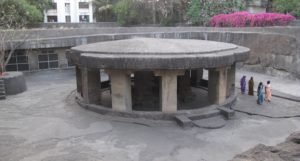
It is dedicated to Lord Pataleshwar- the God of Underwater and Lord Shiva. The design of these temples is similar to those of Elephanta Cave. It was constructed in 8th century and many of its stones date back to 700 to 800 AD. These temples are considered to be a part of the protected monuments category of Pune. The temple has ornate carvings on the black rocks present within it. It is also known for its museum which is listed in the Guinness Book of Records. The museum is known for the grain of rice which has 5000 characters inscribed on it.
The temple is located across the river in Shivaji nagar on Jangali Maharaj Road. The worshippers of Lord Shiva celebrate the Shiva Linga Pooja with much vigour. There are many worshippers who assemble outside the temple to offer their prayers and be a part of the celebration. The temple inculcates massive pillars, a Shiva shrine and a Nandi bull. The temple hence offers a peaceful and delightful historic as well as educational experience to all its visitors.
Shinde Chhatri
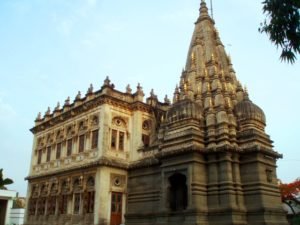
It is a memorial constructed for the Maratha leader, Mahadji Shinde. The memorial is situated in Wanowrie and holds great importance for the Scindia (Shinde) people. It has a hall that happens to be the cremation spot of Mahadji Shinde and was built on 12th February 1974. The memorial has a painted silver likeness of the warrior covered with a flame colored turban and a shawl. Prayer vessels are also kept at his feet and are used to please the Lord every morning.
It is said that the warrior Mahadji Shinde also built a temple for Lord Shiva inside the hall in 1974. The carvings and idols of saints in the temple are made of yellow stone and the sanctum has been constructed of black stone. The memorial bears an Anglo-Rajasthani style and showcases fine regional culture.
The Chhatri or hall has carvings and painting along with a gallery in it. It consists of paintings and photographs of the Sindhia family. It is considered as an insult to the Maratha Lord if opens an umbrella within the memorial.
Ramamani Iyengar Memorial Yoga Institute (RIMYI), Pune
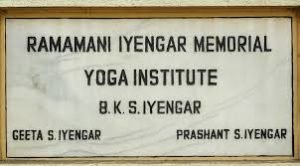
It is the mother institute of Iyengar Yoga worldwide. Here Mr. Iyengar, and his daughter and son, Geeta and Prashant Iyengar, teach and refine the constantly evolving method that is one of the world’s most widely practiced yogas. Here, too, teachers from around the world come to practice and hone the skills they will take back to their own Iyengar Yoga communities. It was established on 19th January 1975. The institute is dedicated to Smt. Ramamani Iyengar, the wife of Yogacharya B.K.S. Iyengar. It is known worldwide for its yogic and moral values that it inculcates to its student. The institute has been designed artistically with three floors called body, mind and soul. It has a height of 71 feet and consists of 8 columns which represent eight limbs of ashtanga yoga viz, yama, niyama, asana, pranayama, pratyahara, dharana, dhyana and samadhi.
The institute has a gallery of awards, citations, presentations, offerings and works of art presented to Guruji. There are 8000 titles of books under various subjects like philosophy, human anatomy and physiology, ayurveda, commentaries on the scriptures, modern medicine and of course yoga.
The institute also celebrates its annual day on the weekend preceding its inaugural date and has a number of programs, discourses on the scriptures, presentations by the students along with cultural and entertainment programs. The institute also publishes “Yoga Rahasya” every quarter. The samples of these publications are also present on its official website. The institute conducts yoga and meditation classes for children as well as adults every morning and evening.
Shaniwar Wada

Bajirao Peshwa built the Shaniwar Wada in 1736. It is a seven storied mansion and served as a seat of political power during its time. It acclaimed tremendous importance and is the city’s main attraction till date. The Shaniwar Wada was largely destroyed by mysterious fires in 1827 which continued to rise during the 19th century and led to the destruction of the entire palace leaving just the mirror hall intact. When visiting the palace, one can still get a view of the leftover plinths, the fortification walls with five gateways, and nine bastions that enclosed the whole complex. The elaborate foundations of the original palace along with the nagarkhana showcasing the wooden pillars and lattice work add up to the beauty of the mansion. The sturdy doors were designed to be protected from the enemy.
Saras Baugh

It is truly one of assets to the city. The place now popular in the form of a park was once upon a time occupied by a lake. It proved, however, a prudent decision to construct a beautiful park in place of the lake. And thus we have Saras Baug, a huge area of 25 acres beautifully developed that attracts oodles of people from Pune and outside.
The Ganesh temple in the park has been the source of inspiration for centuries together for many. It was Sawai Madhavrao Peshwa and Mahadji Shinde, two big names in the Maratha Confederacy, who supervised the construction of the temple. The idol of Lord Ganesh in the temple is made up of flint stone and is an extremely beautiful piece of work. The temple lies pretty close to the Parvati Temple where the Head of the Maratha Confederacy used to stay in the 18th and 19th centuries.
The ponds built around the temple are yet another attraction. You just love looking at the pink and white lotus flowers blooming and blossoming briskly in these ponds. Fish splashing and diving across the pond water are a treat to watch. Especially kids enjoy the sight.
Right at the back of the temple there is a small museum displaying the collection of a few hundred Ganesh idols. Idols crafted in metal, stone, wood, ivory and grains are just exquisite works.
The lush green lawns and the big trees add to the beauty of the place. Saras Baug is a favorite picnic spot for many. Playing outdoor games like cricket, however, is strictly prohibited.
One more attraction is of course a zoo called Peshwe Park, which lies next to Saras Baugh which was constructed in 1969 as a part of the renovation of the area.
Those who want to please their palate have plenty of options available here. Hundreds of snacks centers offer hundreds of varieties. You can enjoy bhelpuri, panipuri, pavbhaji, SPDP, chat and what not. You can enjoy a horse ride as well. And your kids will just love toys like giant wheel, inflated bouncers and slides here.
Pune Okayama Friendship Garden
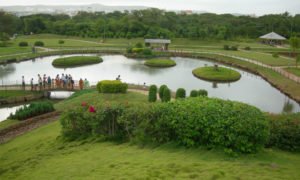
Japanese Gardens are the most beautiful and highly developed of all present day gardens. The Pune Okayama Friendship Garden is based on one of the major gardens of Japan i.e. ” The Korakuen Garden ” in Okayama City, Japan. They are known for their elegant naturalism and charm. The Pune Okayama Friendship Garden located on Sinhgad Road is based on one of the major gardens of Japan i.e. “The Korakuen Garden” in Okayama City, Japan; The Korakuen Garden has a history of 300 proud years. The Pune Okayama Friendship Garden is spread over 10 acres representing the culture and intricate ideologies of an authentic Japanese Garden. The garden is perfect bridge between the two cities of Okayama and Pune, encouraging cultural, traditional, economical, industrial and friendship ties. The characteristics of the garden are a composition of fire, harmony, line spirit world and water. Thus the garden expresses the various elements to speak about light and darkness, soft and hard, stillness and motion, warm and cold. It is based on the Yin and Yang philosophy.
Osho International Meditation Centre, Pune
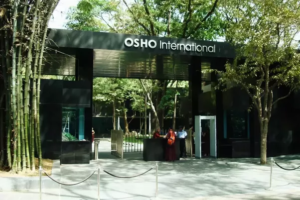
To calm the restless mind, seek inner peace and meditate in tranquillity, the premises of the famous Osho Ahsram in Koregaon Park, is absolutely apt. The cool aura, calm ambience, burbling waters and the angelic sound of birds add to this blissful experience. As the brainchild of Bhagwan Rajneesh, the Osho Ashrama reverberates the teachings and philosophy of Osho. Sprawling across 32 acre of land, the ashram includes a beautifully-maintained park known as Nulla Park or Osho Teertha. The Osho Ashram offers courses like Osho Nataraj meditation, Osho dynamic meditation, Osho Nadabrahma meditation and Osho Kundalini meditation. Although the courses are chargeable yet they offer a great spiritual and peaceful experience. Before entering the Ashrama one has to fill out an application form, submit two passport-sized photographs, pass an on-the-spot HIV test and purchase special tunics. The ashram can be reached by an auto-rickshaw and it is recommended to book your visits in advance. It has a swimming pool, sauna, spa, jacuzzi, gym, tennis court and a boutique guest house.
Raja Dinkar Kelkar Museum

The museum is situated at Bajirao Road and consists of art and crafts collected by late Shri Dinkar Kelkar. The museum has 42 sections and displays 12.5% of everyday art and craft in 6 galleries. Among a few sections the Ivory, Wooden Objects, Lamps, Objects of Beauty Culture, Arms and Armours, Tambol, Mastani Mahal, Terracotta, Toys, Musical Instruments, Leather Puppets, Paintings, Sculptures, Coins, Earthenware, Writing Implements, Bronzes, Textile, Kitchen Utensils, etc are a few.
When entering the museum everyone is welcomed by the ornate wooden arch depicting Agni and Indra and the spectacular lamps.The main attraction of the museum is the Mastani Mahal which also depicts a few of the special exhibitions.
There are 21000 antiques to be displayed amongst which 2500 is on public display since many of them have been spoiled. A project called Museum 2000 has been started to make Dr.Kelkars dream of a educational, recreational and cultural museum come true and is in progress. This project has been conceived by the Board of Management of the museum and is headed by the Chief Secretary to the State of Maharashtra as well as other Government officials. When visiting Pune, this museum must be visited for all travellers as well as history seekers.
Vishrambaug Wada
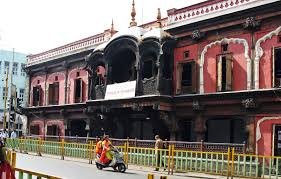
This magnificent mansion is a three storied building and is also known as the Teen Chowki Wada for the same. It was built by the last Peshwa, Bajirao II as his residence. The mansion is 260 feet long and 815 feet broad and is situated on the Thorale Bajirao Road.
The beautiful wada has an eye catching wooden facade and columns carved in Suru form. It was destructed by a sudden fire on October 31, 1880 but was somewhat restored to its original appearance by public subscriptions and municipal contributions. The mansion was initially a Poona Corporation Office until 1958. The Vishrambaug Wada now has a post office on its ground floor and a few other offices of the municipal corporation. It also has a small museum of Maratha artefacts gathered by a Maratha historian.
Parvati Hill

The Parvati Hill is situated in the southern end of the city and it takes 108 steps to climb atop the hill to get a magnificent view of the city. The hill has four temples dedicated to Shiva, Ganesh, Vishnu and Kartikeya respectively situated on top of the hill. The place also has a close association with the Peshwa rulers and is also a part of the Maratha history.
Apart from the temples, there is also a Parvati museum that houses replicas of old manuscripts as well as paintings. The wooden pillars and ceiling pres ent in the museum is of the original dwelling. The museum is a commemoration of the Peshwa rule and has a collection of portraits of the Peshwa rulers. The museum is also the deathbed or Samadhi Sthan of Shrimant Nanasaheb Peshwa. This historical place is just at few footsteps from Bhagirathi Ayurveda Centre, Pune, India.
Mahatma Phule Mandai
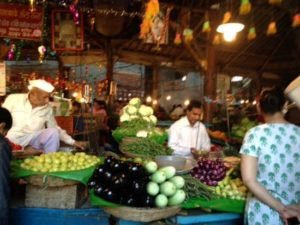
The Mandai is the largest vegetable market of Pune city since 1885. It is officially known as “Mahatma Phule Mandai.” The market has a total of eight entrances but the main entrance is connecting Sanipar to Chhatrapati Shivaji road. The entrance to the market can easily scare off a newbie because of the massive crowd of the locality. Sometimes during particular seasons, people describe the lane to be so crowded that there is no place to set a foot inside. According to the people, the market had started with only 134 stalls at the beginning and now it has about 530 stalls. The market does not just provide fruits and vegetable at a cheap rate but also provides fruits and vegetable of all ranges regarding their quality. So the rates differ according to the quality you’re buying. Although all the other Peths of Pune.